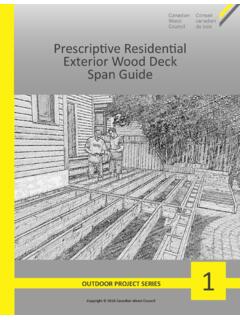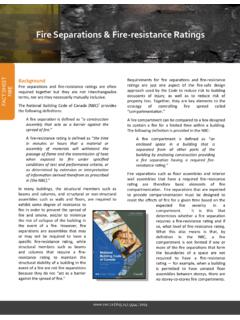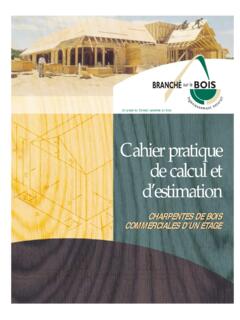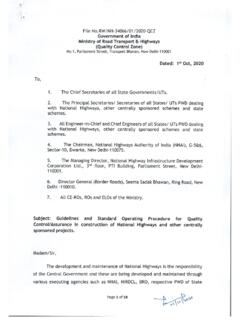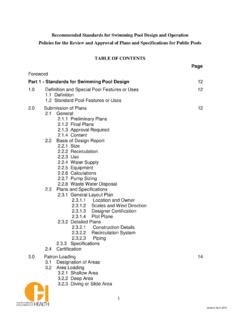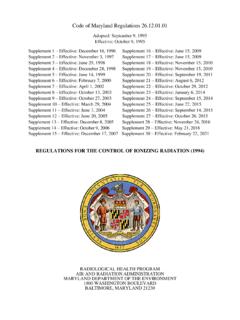Transcription of Wood Trusses - CWC
1 Wood Trusses Strength, Economy, VersatilityNO. 2 InternatIonalBuilding seriesNO. 2 InternatIonalBuilding seriesIntroductionWood Trusses are engineered frames of lumber joined together in triangular shapes by galvanized steel connector plates, referred to commonly as truss plates. wood Trusses and increasingly, wood floor Trusses are being used in residential and commercial applications. Wood truss use is not limited to North America. They are gaining acceptance around the world and are widely used in Europe and Trusses are widely used in single- and multi-family residen-tial, institutional, agricultural and commercial construction.
2 Their high strength-to-weight ratios permit long spans, offering greater flexibility in floor plan layouts. They can be designed in almost any shape or size, restricted only by manufacturing capabilities, shipping limitations and handling plate connected roof Trusses were first introduced into the North American market in the 1950 s. Today, the majority of house roofs in Canada and the United States are framed with 2We ve Come a Long WayWood Trusses | Strength, Economy, Versatility3 Research has led to improved materials, design procedures and manufacturing technologies for wood Trusses . Truss plates used to con-nect the wood pieces together have been optimized for strength and cost.
3 Lumber manufacturing and grading technologies have evolved to allow more efficient use of the wood resource. Computers have been widely used to optimize truss design and make the manufac-turing process more first light frame Trusses were built on site using nailed plywood gusset plates. These Trusses offered acceptable spans but demanded considerable time to build. Economy: Through effi-cient use of wood and by pro-viding a system that is quickly installed in the field, wood Trusses provide an economical framing solution. Versatility: Complex shapes and unusual designs are easily accommodated using wood Trusses .
4 The versatility of wood Trusses makes it an excellent roof framing system in hybrid construction where wood Trusses are commonly used with steel, concrete or masonry wall systems. Environmental: Wood, the only renewable building material, has numerous environ-mental advantages. Wood Trusses enhance wood s environmental advantages by optimizing wood use for each specific in materials, design and manufacturing technologies have increased wood truss the 1950 s the metal connector plate transformed the truss industry by allowing efficient prefabrication of short and long span Trusses . In North America the wood truss industry has grown to the point where more than 60% of residential roofs are now built with wood Trusses .
5 In Canada, approximately 95% of new houses are built with wood roof the advantages of wood Trusses are considered, it is not surprising that their use is increasing throughout the world. Strength: Trusses provide a strong and efficient wood system specifically engineered for each 2 InternatIonalBuilding seriesWood Truss TechnologyThere are a number of steps involved in the production and installation of a truss. A truss is designed for a specific application, manufactured in accordance with the truss design, delivered to the building site and safely installed in accordance with the North America, designs are based on the structural requirements of the Building Codes using design standards referenced in the Building Codes and approved material properties:the building designer or builder will contact the truss fabricator who will supply a fully engineered truss.
6 The truss plate manufacturer usually designs the truss on behalf of the truss fabricator. Truss DesignThe truss design is initiated by the building designer who must specify; the shape and span of the truss, where the truss will be supported and what the loads on the truss will be. Typically, 4 Roof Trusses : Light Trusses are manufac-tured to suit virtually any roof profile. Pitched or flat, they are only limited to the load arrangements and the support Trusses : Flat Trusses , also known as parallel chord Trusses , are an alternative to conventional wood floor joist systems and are a competitive option to open web steel joist systems.
7 Parallel chord floor Trusses may be designed with varying chord and web arrangements and bearing support Chord (flat) TrussPitched (triangular) TrussFinkMonoScissorsRoom-in-AtticFigure 1: Truss Nomenclature and Common Truss ShapesPanel lengthPanel lengthPanel lengthClear spanClear spanOverall lenghtOverall lenghtLateral bracingTop chordWebsPanel pointBottom chordTruss platePanel pointTop chordTruss plateWebBottom chordBearing pointLevel returnoverhandBuilt-in camberWood Trusses | Strength, Economy, Versatilityplate manufacturers carry out a series of tests to determine the design properties for each type of plate. Many sizes and gauges of con-nector plates are manufactured.
8 The most common plates use 16, 18 or 20- gauge (US Standard gauge ) sheet steel, in widths of 25 mm to 250 mm and lengths up to 600 mm. The stamping results in teeth with dimensions varying from 6 mm to 25 Truss bearing and uplift requirements, and Truss member bracing MaterialsWOOdAll lumber used in Trusses is graded using either a visual process or machine stress rating in accordance with national standards. In the visual grading process, each piece of lumber is visually examined and the wood grade is based on the size of growth characteristics that could affect the strength and stiffness of the member.
9 Each piece of machine stress rated lumber undergoes a stiffness evaluation in addition to a visual minimum size of lumber used is 38 x 89 mm for chords and 38 x 64 mm for webs. The size of the members increases according to loading, span and truss spacing. In some long-span applications, multi-ply Trusses are used to increase PLATeSThe truss connector plates are proprietary products. They are made of galvanized steel and manufactured by high speed stamping machines that punch out the plate teeth and shear the plate to the required size. Truss Structural analogues and methodology have been developed and standardized by the National Associations representing the manufacturers of the metal plate design values are determined in accordance with the wood design connector plates are proprietary and each plate has different structural properties.
10 Design values for truss plates are developed through tests and analyses in accordance with referenced standards. Approval of the design values is overseen by National certifi-cation design is facilitated by the use of computer software that designs all truss members and connections and produces a design drawing with all the essential truss information. Included on the drawing (see Figure 2) is: The truss geometry, The loads used in the truss design, Species, size and grade of all wood members, Size and location of all connector plates,Truss Connector PlatesLaboratory Testing of Wood TrussesNO.

